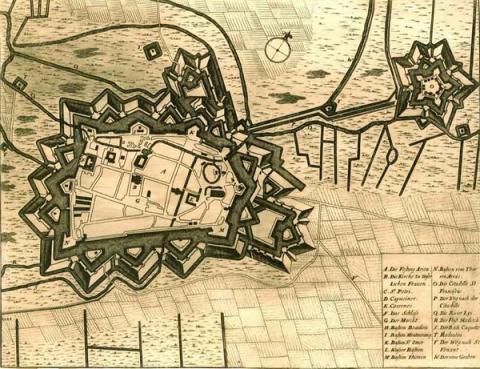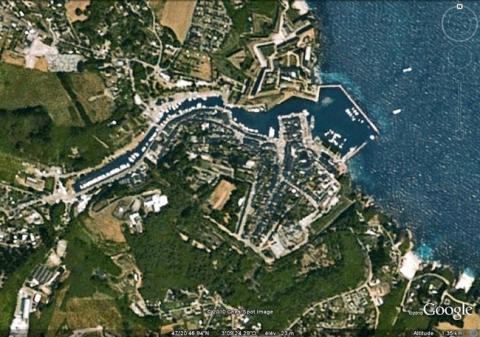Le Palais
History and description
The largest of the Breton isles saw the first fortified works built in the 14th century. The first bastioned fort was constructed in the small town of Le Palais in around 1550 by Francis de Rohan, lieutenant general of Brittany for King Henri II. It was a square fort with four bastions. In 1572, this initial fort was modernised by the Gondi family, following a protestant siege. The bastions were redesigned and equipped with double shooting ledges. A first rampart and a protected walkway were also added to the urban wall. In 1658, Nicolas Fouquet, who was Superintendent of Finances, bought the isle and standardised the layout of the fort to the South. He also added a ravelin, small parade grounds, traverses and a glacis to the north and west, as well as an arsenal and a circular powder keg in the ramparts. This construction was achieved despite the disgrace of Fouquet and the change in status of the fortress in 1661: from a naval defence fort, Belle-Île became a royal citadel.In 1680, Vauban visited the site, which Louis XIV wished to reinforce, following a Dutch raid in 1674. After analysing the situation multiple times, he drafted a new project on 30 March, 1683. This involved replacing the primitive protective of the citadel with a new and larger installation, built around the first rampart of Gondi. This was therefore intended to replace the covered way. Around twenty redoubts and artillery batteries were also constructed around the citadel and elsewhere on the isle to improve the defences. In 1689, during the third visit of Vauban (the second of which was in 1685), the gate of the keep was replaced by the current embodiment, in response to a wish for improvement. It was in 1696, that Aiguade was constructed (a rare example of fresh water supply on the Atlantic side) and the Taillefer battery.
In his projects, Vauban also planned for the construction of a bastioned urban wall around the small town of Le Palais and significant improvements made to the port. However, while construction on the citadel was achieved at the start of the 18th century, the protective urban wall was not immediately constructed. It was not until the first Empire that construction of this urban wall got underway, namely in 1803. This work was then suspended under the Restoration and the July Monarchy, to be later continued and completed under the Second Empire (around 1860-1870), the latter of which included multiple small forts added along the coasts of the isle. The urban wall, constructed in accordance with the projects of the Napoleonic general Marescot, included three bastions linked by a dry ditch and preceded by a counterscarp for counter fire. Two inner fortified structures with parade grounds were alongside the covered way. An entrenched camp was supposed to be added to the north of the citadel but ended up incomplete. As for the citadel, it was completely restored after 1763, following a siege and two years of occupation by the English.
Current state
The citadel still stands, likewise the urban wall and multiple external structures. The citadel has been classed as a historical monument since 2007. From 1960 to 2000, it was restored by a couple of enthusiasts. Since 2000, it has been in the ownership of a hotel group. The municipality of Le Palais is the owner of the urban wall and other external works. All are open to visitors. The relief map constructed in 1704 at a scale of 1/600 and restored in 1920, survived and is on show at the musée des Invalides in Paris.
Le Palais
Le Palais
47° 20' 50" N, -3° 9' 15" E
Type
citadel, urban wall
Engineers
François de Rohan, Albert de Gondi, Sébastien le Prestre de Vauban, Samuel de Marescot
Department
Morbihan
Region
Bretagne
Bibliography
- ASSOCIATION VAUBAN, Vauban à Belle-Île, Le Palais, 1990.
- FAUCHERRE (N.), Places fortes, bastions du pouvoir, Paris, 2000, p. 101-104.
- FAUCHERRE (N.), LECUILLIER (G.), La route des fortifications en Bretagne Normandie, Paris, 2006.
- FONTENEAU (J.-M.), La citadelle de Belle-Île-en-Mer, Rennes, 1995.
- LANCO (G.), La citadelle de Belle-Île, édification et justification, Le Palais, 1982.
- NICOLAS (M.), Le Palais : la citadelle, synthèse historique et architecturale, Rennes, 2006.
- TAFOIRY (N.), Belle-Île-en-Mer, s. l., 2006.
- WARMOES (I.), Le Musée des Plans-Reliefs, Paris, 1997, p.61.

